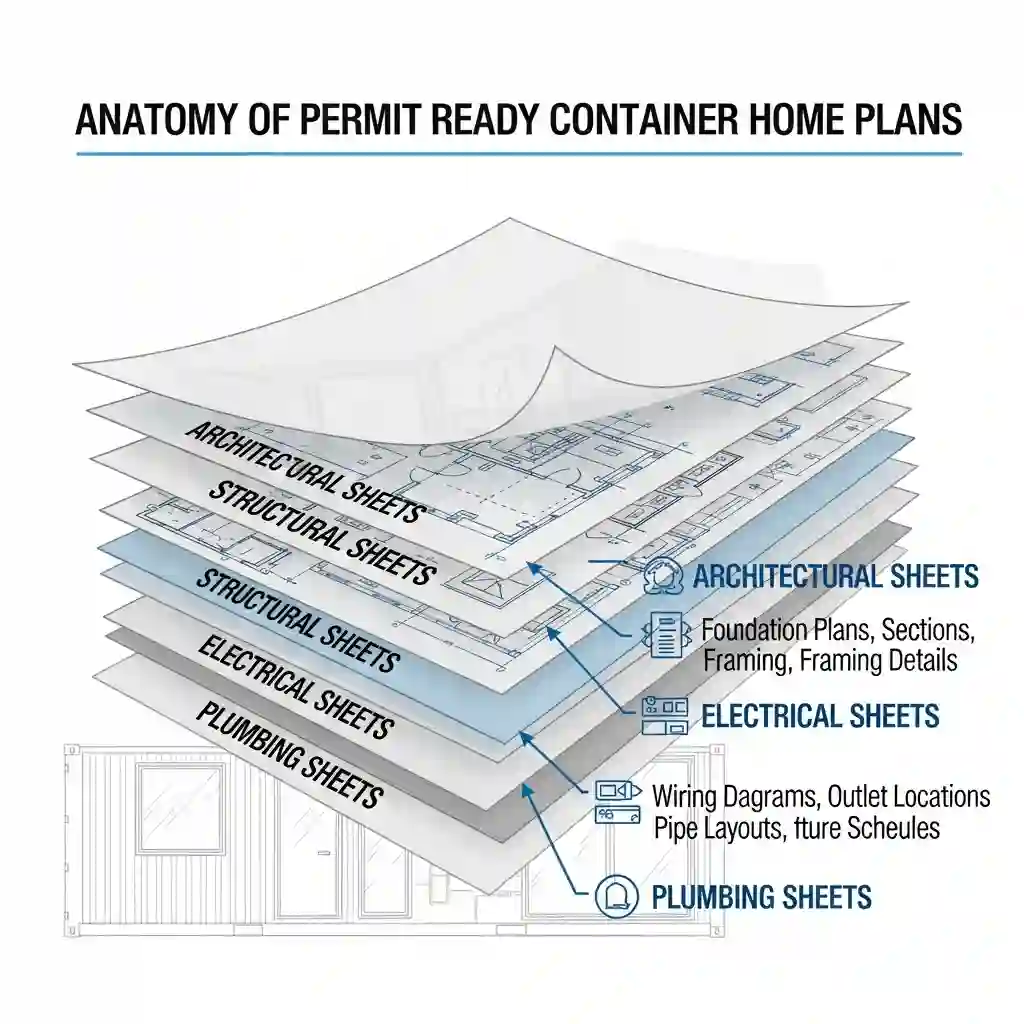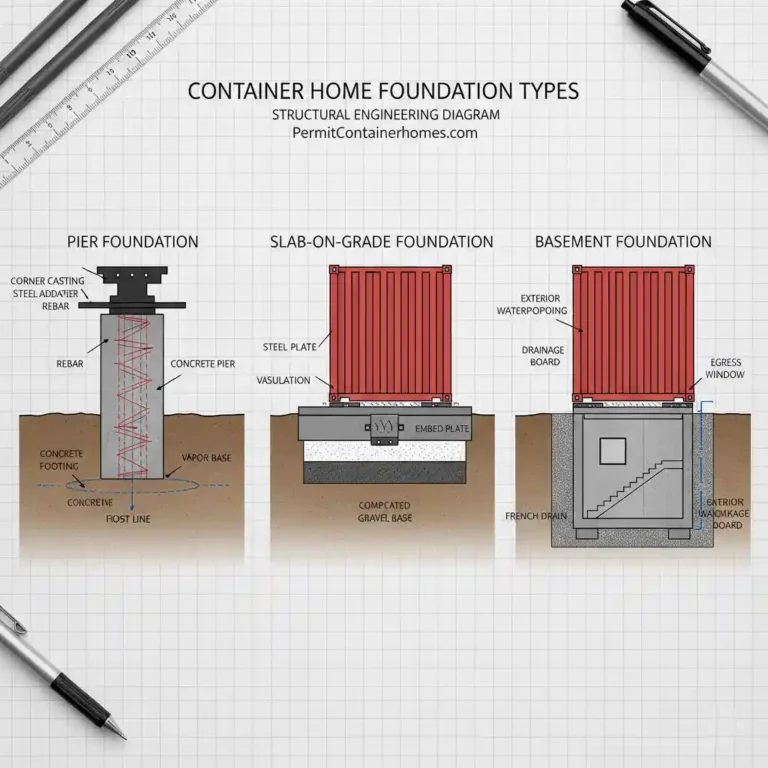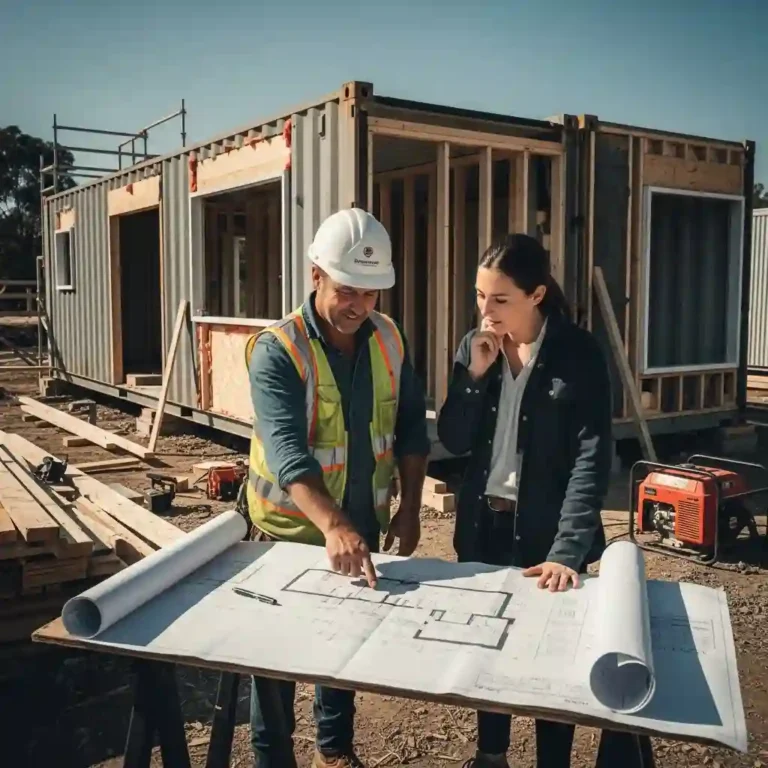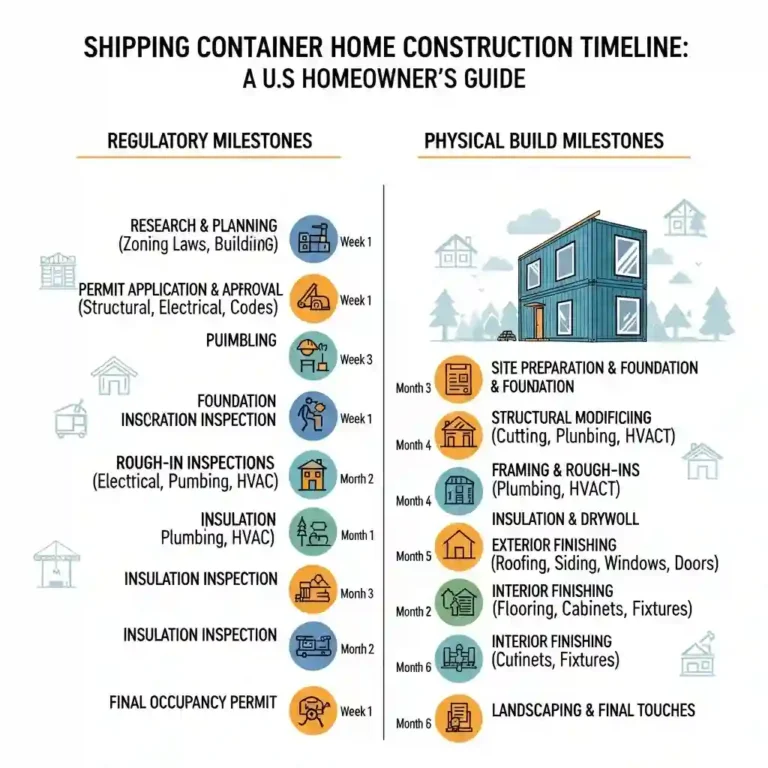Permit Ready Container Home Plans: The Ultimate 2025 Guide to Fast Approvals
Demystifying the most misunderstood term in container construction: What you get, what you need, and how to sail through the building department.
Imagine this: You’ve spent months dreaming of your sustainable shipping container home. You found a cheap design online, bought your land, and excitedly walked into your local building department to submit your application. Ten minutes later, you’re walking back out, dejected, holding a red-inked rejection letter because your plans lacked critical structural details, energy calculations, or code references. This heartbreaking scenario is all too common for first-time owner-builders. It’s usually the moment they realize that a pretty 3D rendering is not the same as a buildable, legal document.
This is where the concept of permit ready container home plans comes into play. But this term is often misunderstood, sometimes leading to unrealistic expectations. As your partner in this journey, we want to clear the air. “Permit-ready” doesn’t mean you can simply print a PDF and start pouring concrete tomorrow. It means you are starting with a professional, code-compliant foundation of documents that does 90% of the heavy lifting, saving you thousands of dollars and months of design time compared to starting from scratch. In this comprehensive guide, we will unpack exactly what “permit-ready” means, dissect the anatomy of a professional plan set, and walk you through the collaborative final steps to get your official “Approved for Construction” stamp.
The “Permit-Ready” Reality Check: Managing Expectations
Before we dive into technical details, let’s establish a clear, honest definition of what permit ready container home plans are—and equally important, what they are not. Misunderstanding this distinction is the number one source of frustration for new builders.
What “Permit-Ready” Means
A permit-ready plan set is a comprehensive collection of architectural and engineering drawings designed to meet the baseline requirements of the major U.S. building codes, specifically the International Residential Code (IRC) and the International Building Code (IBC). These plans have been developed by professionals who understand structural loads, egress requirements, energy efficiency, and safety standards.
When you purchase permit ready container home plans from a reputable source like PermitContainerhomes.com, you are receiving:
- A Code-Compliant Baseline: The home is designed so that hallways are wide enough (IRC R311.6), ceiling heights meet minimums (IRC R305), and sleeping rooms have proper emergency escapes (IRC R310).
- Structural Integrity: The plans detail how the containers are modified, reinforced, and connected to ensure they don’t collapse under their own weight or normal use.
- Complete Systems Layouts: You get detailed schematics for electrical, plumbing, and mechanical systems that a contractor can actually bid on and build from.
What “Permit-Ready” Does NOT Mean
This is crucial: No stock plan purchased online can be 100% ready for your specific building department the second you download it. Why? Because the internet doesn’t know where you live.
- It is NOT Site-Specific: The plans don’t know if you are building on flat sandy soil in Florida or a rocky slope in Colorado.
- It is NOT Climate-Specific: While designed to a high standard, standard plans may need adjustments for extreme local snow loads (e.g., 80 lbs/sqft in Tahoe) or hurricane wind loads (e.g., 150 mph in Miami).
- It is NOT a Guaranteed Instant Approval: Every local jurisdiction has unique quirks, amendments to the code, or specific zoning requirements that no national plan provider can predict entirely.
Anatomy of a Permit-Ready Plan Set
To understand the value of true permit ready container home plans, you need to know what’s inside them. A building official doesn’t just want to see what the house looks like; they need to prove it won’t burn down, fall over, or trap its inhabitants. A professional set typically includes 15 to 30+ pages of dense technical data, broken down into several key series.
1. The ‘G’ Series: General Project Information
This is the cover sheet and index. It sets the stage for the inspector, confirming which codes the plans were designed to (e.g., “Designed in accordance with 2021 IRC”). It typically includes general notes on materials, workmanship standards, and safety protocols. It frames the entire project as professional and compliant from page one.
2. The ‘A’ Series: Architectural Plans
These sheets define the look, feel, and spatial functionality of the home. They are what most people think of when they hear “blueprints.”
- Floor Plans: Detailed overhead views showing every wall, door, window, and room dimension. Crucially for permits, these show compliance with minimum room areas and egress paths.
- Elevations: Straight-on views of all four exterior sides of the home. These show exterior finishes, roof pitches, and overall maximum heights, which are often critical for zoning height restrictions.
- Cross-Sections: Imagine slicing the house in half like a cake. These views show how the walls, floors, and roof come together. They detail insulation layers, interior heights, and vertical relationships between spaces.
- Roof Plan: A bird’s-eye view of the roof, showing drainage slopes, gutters, and penetration points for vents or chimneys.
3. The ‘S’ Series: Structural Plans
For container homes, this is arguably the most critical section for permit approval. Building departments are skeptical of containers; these sheets are your defense.
- Foundation Plan: Shows the concrete piers, slab-on-grade, or stem walls that will support the containers. It details footing sizes, rebar schedules, and anchor bolt locations to ensure the home stays attached to the earth.
- Container Modification Details: You cannot just cut a whole side out of a shipping container without it buckling. These sheets specify exactly where steel reinforcement (like square tube steel frames) must be welded around new window and door openings to restore structural integrity.
- Connection Details: How do you stack two containers and ensure they don’t slide off each other in an earthquake? These details show the specific weld plates, twist locks, or bridge fittings required by code.
- Framing Plans: Details for any traditional wood or metal framing used for interior walls, roofs built over the containers, or stick-built additions.
4. The ‘M’ Series: Mechanical (HVAC) Plans
These ensure your home is habitable and energy-efficient. They show the location of heating and cooling units (like mini-splits), ductwork runs (if any), and exhaust fans for bathrooms and kitchens. Proper ventilation is a key health and safety code requirement (IRC Section M1505).
5. The ‘E’ Series: Electrical Plans
Electrical fires are a major concern for code officials. These sheets must be incredibly detailed.
- Power & Lighting Plan: Shows the location of every outlet, light switch, and fixture. It ensures you meet code requirements, such as having an outlet within 6 feet of any point along a habitable wall (IRC E3901.2).
- Panel Schedule & Load Calculations: A mathematical breakdown proving your electrical service panel (e.g., 200 Amp) can handle the projected load of all your appliances without overloading and causing a fire hazard.
6. The ‘P’ Series: Plumbing Plans
These sheets ensure clean water gets in and dirty water gets out without cross-contamination or dangerous sewer gas leaks.
- Drain, Waste, and Vent (DWV) Plan: Shows the piping routes for sewage and, crucially, the vent stacks that go through the roof. Improper venting is a common reason for inspection failure.
- Supply Line Plan: Shows the routing of hot and cold water lines to all fixtures.
- Riser Diagrams: A vertical schematic showing the entire plumbing tree, often required by more strict jurisdictions to prove varying pipe diameters meet flow requirements.
Why Generic Online Plans Fail Inspection
The internet is flooded with “container home plans” for $50 that are little more than conceptual sketches. Submitting these to a building department is often a waste of application fees. Here is why generic plans almost always fail the initial review:
❌ Missing Structural Reinforcement Details
Generic plans often show huge glass walls but fail to specify the heavy-duty steel headers and columns needed to support the roof above those cuts. Inspectors know containers are weak when cut and will immediately reject plans that ignore this reality.
❌ Ignoring Energy Codes (Insulation)
Simply writing “insulate walls” is not enough. Modern energy codes (like the IECC) require specific R-values. A plan that doesn’t detail how you will achieve R-20+ in a thin container wall (e.g., closed-cell spray foam specifications) will be flagged.
❌ Non-Compliant Dimensions
We often see amateur plans with hallways that are 30 inches wide (code minimum is typically 36 inches) or ceiling heights that drop below 7 feet in habitable spaces due to improperly planned ductwork or insulation. These are fundamental code violations that require a complete redesign.
❌ Lack of Egress Windows
Every sleeping room must have an escape window large enough for a firefighter to enter with full gear. Generic plans often use standard small container windows in bedrooms, which are illegal and deadly in a fire scenario.
Our permit ready container home plans are designed specifically to avoid these common pitfalls, incorporating standard code requirements from the earliest design phases.
The Critical Role of Your Local PE (Professional Engineer)
If you take one thing away from this guide, let it be this: Even the best permit-ready plans usually require a local Professional Engineer’s stamp.
This is not a failing of the plans; it is a legal necessity of the U.S. building regulatory system. Building codes are adopted and enforced at the state, county, or city level. A building official in California needs assurance that the foundation will survive a magnitude 7.0 earthquake, while an official in Minnesota needs assurance the roof won’t collapse under 4 feet of snow.
What the Local PE Does
You will take our CAD or PDF files to a local structural engineer. Their job is to review our baseline engineering and “bless” it for your specific lot. They will:
- Verify Local Loads: They check our roof design against your exact county’s snow and wind load data.
- Design Site-Specific Foundations: They will look at your soil report (which you may need to commission) and determine if our standard foundation works or if you need deeper piers due to unstable soil or a high frost line.
- Apply Their Stamp: They place their state-licensed seal on the plans, taking legal responsibility for the structural safety of the building in that specific location. This stamp is the “golden ticket” for most building departments.
By starting with our permit ready container home plans, you save the local engineer dozens of hours of drawing time. They aren’t designing from scratch; they are reviewing and stamping an existing professional design. This typically costs 60-80% less than hiring them to do the whole job.
Step-by-Step: From Purchase to Permit
How do you actually use these plans to get your building permit? Here is the typical workflow our successful customers follow.
Step 1: Purchase and Download
Select the design that best fits your needs from our shop. You’ll receive digital files (PDF and often CAD format) immediately. The CAD files are crucial as they allow your local professionals to easily make edits.
Step 2: Pre-Application Meeting
Take your printed preliminary plans to your local building department for an informal meeting. Ask them: “These are the plans I intend to use. What specific local amendments or extra documents will you require from me?” This proactive step builds rapport and prevents surprises.
Step 3: Local Engineering Review & Site Plan
Hire your local PE to review and stamp the structural sheets. Simultaneously, you may need to hire a surveyor or draft a “Site Plan” yourself (if allowed). The site plan shows where on your land the container home will sit, proving you meet setbacks from property lines.
Step 4: Formal Submission
Submit the complete packet: our architectural/MEP plans, the locally stamped structural plans, your site plan, and the permit application fee.
Step 5: The Review Period
Wait. This can take anywhere from 2 weeks to 6 months depending on how busy your local jurisdiction is.
Step 6: Addressing Redlines
It is very common to get the plans back with “redlines”—notes from the plan reviewer asking for clarifications or small changes (more on this below). You or your local pros make these small updates and resubmit.
Step 7: Permit Issuance
Once all redlines are addressed, you pay the final permit fees, and you receive your “Job Card” and stamped approved plans. You are now legally allowed to break ground!
Understanding “Redlines” and Revisions
Receiving “redlines” can be scary, but it’s a normal part of construction. A redline doesn’t mean the plans are bad; it often just means the plan reviewer needs more specific information about a detail relevant to their town.
Common Redline Examples:
- “Please specify the exact model of tankless water heater to confirm BTU input.”
- “Show location of smoke detector in Bedroom 2 on electrical plan.” (Sometimes these just get missed in quick reviews).
- “Provide manufacturer cut sheet for the specific closed-cell spray foam product being used.”
Because you own the CAD files of our permit ready container home plans, making these small adjustments is usually quick and easy for any drafter, architect, or contractor you are working with.
Cost Analysis: Permit-Ready vs. Custom
Why choose pre-designed plans instead of hiring an architect from day one? The primary drivers are cost and speed. Creating a full set of construction documents from a blank sheet of paper is incredibly time-consuming.
| Expense Category | Custom Architect/Engineer Route | Permit-Ready Plans Route |
|---|---|---|
| Initial Design Fees | $5,000 – $15,000+ | $500 – $1,500 (Plan Purchase) |
| Time to First Draft | 8 – 16 Weeks | Instant Download |
| Local Engineering Stamp | Included in high fees, or extra | $1,500 – $3,500 (estimated average) |
| Total Estimated Pre-Construction Design Cost | $6,500 – $20,000+ | $2,000 – $5,000 |
By using permit ready container home plans, you are essentially crowd-sourcing the initial high cost of architectural design. Because we sell the same plan multiple times, we can offer a $10,000 value plan set for a fraction of the price to you.
Choosing the Right Plans for Your Land
Before you buy, you need to ensure the plan you love can actually be built on your land. Permit ready container home plans only work if zoning allows them.
🔍 Pre-Purchase Checklist:
- Check Minimum Square Footage: Some zones require homes to be at least 1,000 sq ft. A single 40ft container home (320 sq ft) would not be permitted there, regardless of how good the plans are.
- Check Container Restrictions: Some HOAs or municipalities explicitly ban shipping containers. Always verify this first.
- Check Exterior Requirements: Some areas require specific types of siding (like stucco or masonry) and won’t allow the exposed corrugated steel look.
Once you’ve confirmed these basics, you can confidently browse our collection, knowing you’re starting with a professional, viable product.
❓ Frequently Asked Questions
Do I absolutely need a structural engineer if I use permit ready container home plans?
In 95% of jurisdictions in the United States, yes. Because shipping containers are non-standard building materials (unlike 2×4 wood framing), building officials almost always require a state-licensed engineer to verify that the modifications are safe. Our plans provide all the calculations the engineer needs to do their review quickly, but their stamp is the final legal requirement for the city.
Can I modify your permit ready container home plans?
Yes! We provide CAD files with many of our plan packages specifically for this purpose. You can take these files to any local architect, drafter, or engineer to make changes—like moving a window, adding a deck, or mirroring the layout—before submitting them for permits.
Are these plans guaranteed to be approved in my state?
No reputable company can offer a 100% guarantee of approval because every local municipality has the authority to amend the building code. However, our plans are designed to the International Residential Code (IRC), which is the model code used by most US states. They are excellent starting points that typically only invariably require minor site-specific adjustments rather than complete redesigns.
Do your plans include a site plan?
No, because we do not know the dimensions, slope, or orientation of your specific piece of land. A site plan must be created individually for every project to show property lines, setbacks, well/septic locations, and driveway access. You can often draw a simple one yourself, or hire a local surveyor to create one to accompany our building plans.
What if my building department has questions about the plans?
We stand behind our designs. If your building official needs clarification on a design intent within our standard plans, you can contact us for support. For questions related to local site conditions (like soil bearing capacity), your local engineer will be the best resource to answer them.
Start Your Build on Solid Ground
Don’t risk your budget on conceptual sketches. Browse our catalog of professional, architect-designed plans that give you the head start you need for a smooth permitting process.
Find Your Permit-Ready PlanFound the perfect layout but need to tweak it for your view? We offer a professional plan modification service after purchase to perfect your design. Just contact us for a personalized quote!
Important: Our plans are “permit-ready” in that they are complete, code-compliant designs. However, they almost always require review and stamping by a local licensed Professional Engineer (PE) in your specific jurisdiction to account for local site conditions (wind, snow, soil, seismic). Final approval is subject to local building department authority.
Financial Disclaimer: The cost comparisons provided are estimates based on national averages and can vary significantly by region and current market rates for professional services.
Refund Policy: Due to the immediate digital nature of our plan downloads, all sales are final. Please review our Refund Policy and ensure your local zoning allows container homes before purchasing.




